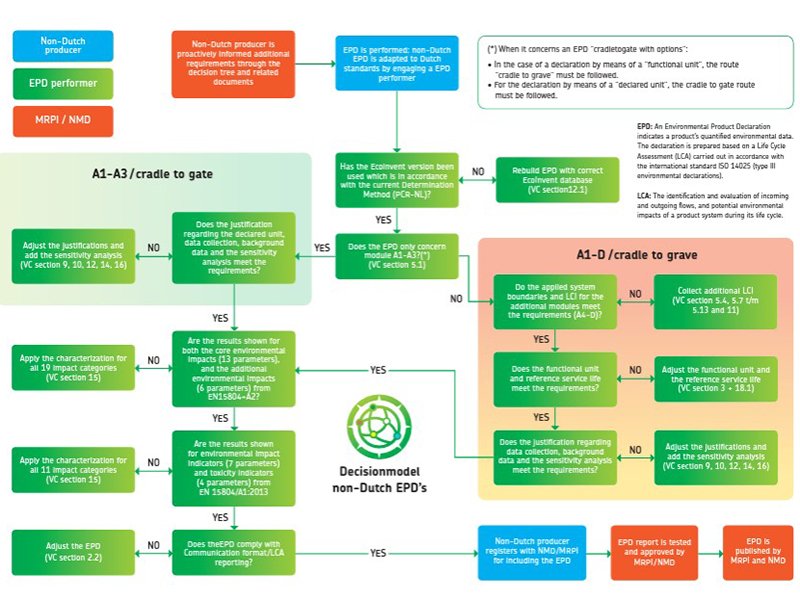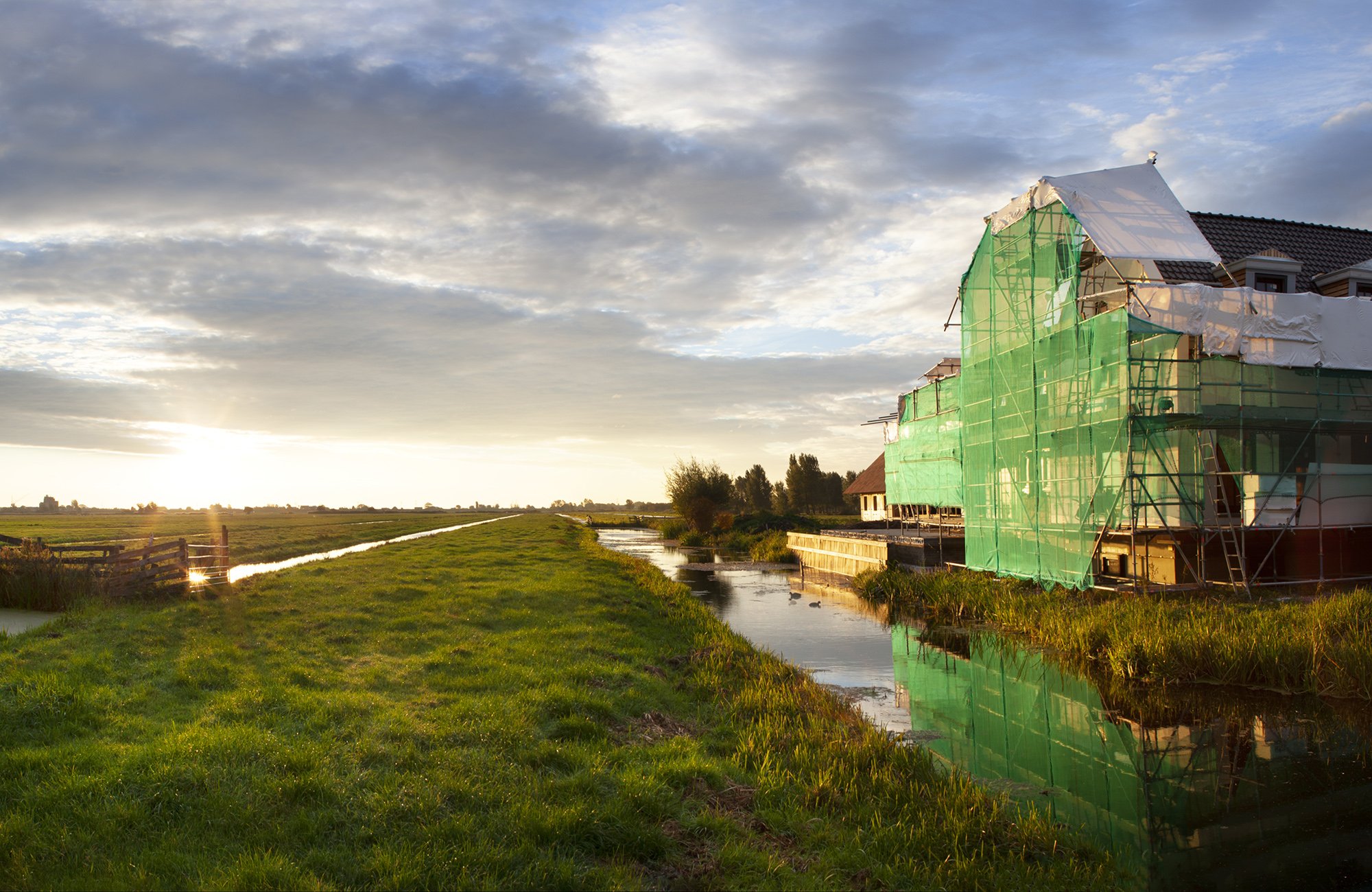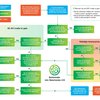Non-Dutch LCAs and EPDs in the NMD
The Dutch Environmental Database sets additional requirements for LCAs and EPDs used in the Netherlands. This page offers LCA practitioners practical information on the application of the Assessment Method and the steps required to make data suitable for inclusion in the Dutch Environmental Database.

Non-Dutch LCAs in the Dutch Environmental Database
Construction products from foreign (non-Dutch) manufacturers or industry associations can be included in the Dutch Environmental Database, provided that a Life Cycle Assessment (LCA) has been compiled in accordance with the Environmental Performance Assessment Method for Construction Works (Assessment Method).
If a foreign LCA or Environmental Product Declaration (EPD) is already available, adjustments are often required to meet the Dutch data quality requirements. Taking this into account at an early stage can help avoid unnecessary delays and additional costs during the LCA study and the data inclusion process in the database.
Background
The European standard EN 15804 (A1 + A2:2019) forms the basis for Life Cycle Assessments (LCAs) of construction products. This standard provides guidelines for compiling an LCA that calculates the environmental impact of a construction product. Across Europe, EN 15804 is widely applied to record the environmental performance of products in Environmental Product Declarations (EPDs).
In the Netherlands, a legal requirement applies to the environmental performance of buildings (MPG). Therefore, data quality and mutual comparability are of great importance. To ensure this, the Dutch Environmental Database Foundation sets additional requirements for data quality, on top of EN 15804. These additional requirements are laid down in the Assessment Method.
For international parties that wish to have their data included in the Dutch Environmental Database, it is essential to be well informed about these additional requirements. This ensures that the data align with the Dutch methodology and are properly comparable with existing information. An LCA or EPD that complies with the Dutch Assessment Method also automatically complies with the European EN 15804. As a result, it is also suitable for use elsewhere in Europe.
Step-by-step plan for inclusion in the Dutch Environmental Database
Read more here about the process of submitting data to the Dutch Environmental Database.
No LCA/EPD available yet
If no LCA or EPD has been compiled yet, the Dutch data quality requirements can be taken into account from an early stage. To have an LCA compiled for inclusion in the Dutch Environmental Database, you can contact one of our recognised LCA practitioners or the Association for LCAs in Construction (VLCA).
Have an LCA / EPD adjusted
An existing LCA or EPD must meet the Dutch data quality requirements in order to be included in the Dutch Environmental Database. The paragraph ‘Information for LCA practitioners’ below outlines a step-by-step plan for adapting an LCA / EPD for inclusion in the Dutch Environmental Database. These steps can be carried out by the original LCA practitioner. Alternatively, a recognised LCA practitioner listed by the Dutch Environmental Database can be selected, as they have more experience with the Dutch system and can ensure that all requirements are met.
Information for LCA practitioners
When a foreign manufacturer wishes to have a construction product included in the Dutch Environmental Database, the accompanying data must comply with the requirements set out in the Environmental Performance Assessment Method for Construction Works (Assessment Method). This methodology serves as a generic Product Category Rule (PCR) for construction products within the Dutch environmental performance framework.
This page explains the content-related additions imposed by the Assessment Method on top of the European standard EN 15804. To support this process, an interactive checklist is available.
Data requirements
The Assessment Method sets out various requirements, including for the use of:
- Background databases
- Transport distances
- Default waste scenarios
- Allocation
- Calculation method
The amount of work required to align an existing LCA with the Assessment Method depends on the nature and extent of the necessary adjustments. In many cases, existing LCI data can be reused, but a different calculation method may need to be applied, for example. If the correct version of the Ecoinvent background database has not been used, selecting the appropriate processes can be relatively labour-intensive.
Decision tree
To support LCA practitioners in checking whether data comply with the Assessment Method, a decision tree has been developed. The decision tree can be downloaded as a PDF at the bottom of this page. An interactive Excel file is also available, which guides users step by step through any necessary adjustments and refers to relevant web pages. Both documents are based on, and refer to, the Verification Checklist for inclusion in the Dutch Environmental Database issued by the Dutch programme operator MRPI (see downloads).

Adapting an LCA
The Excel checklist or decision tree will often identify one or more required adjustments to make the data suitable for inclusion in the Dutch Environmental Database. The manufacturer can choose to have these adjustments carried out by the original LCA practitioner or by a recognised LCA practitioner listed by the Dutch Environmental Database who is familiar with the Dutch environmental performance framework.
In both cases, it is mandatory for the adjusted data to be reviewed by a recognised LCA verifier before it can be included in the database.
Downloads
Subscribe to our Newsletter
Sign up for our newsletter and receive monthly updates on sustainable construction, environmental performance, environmental data, policy, and other relevant news from the Dutch Environmental Database Foundation.



